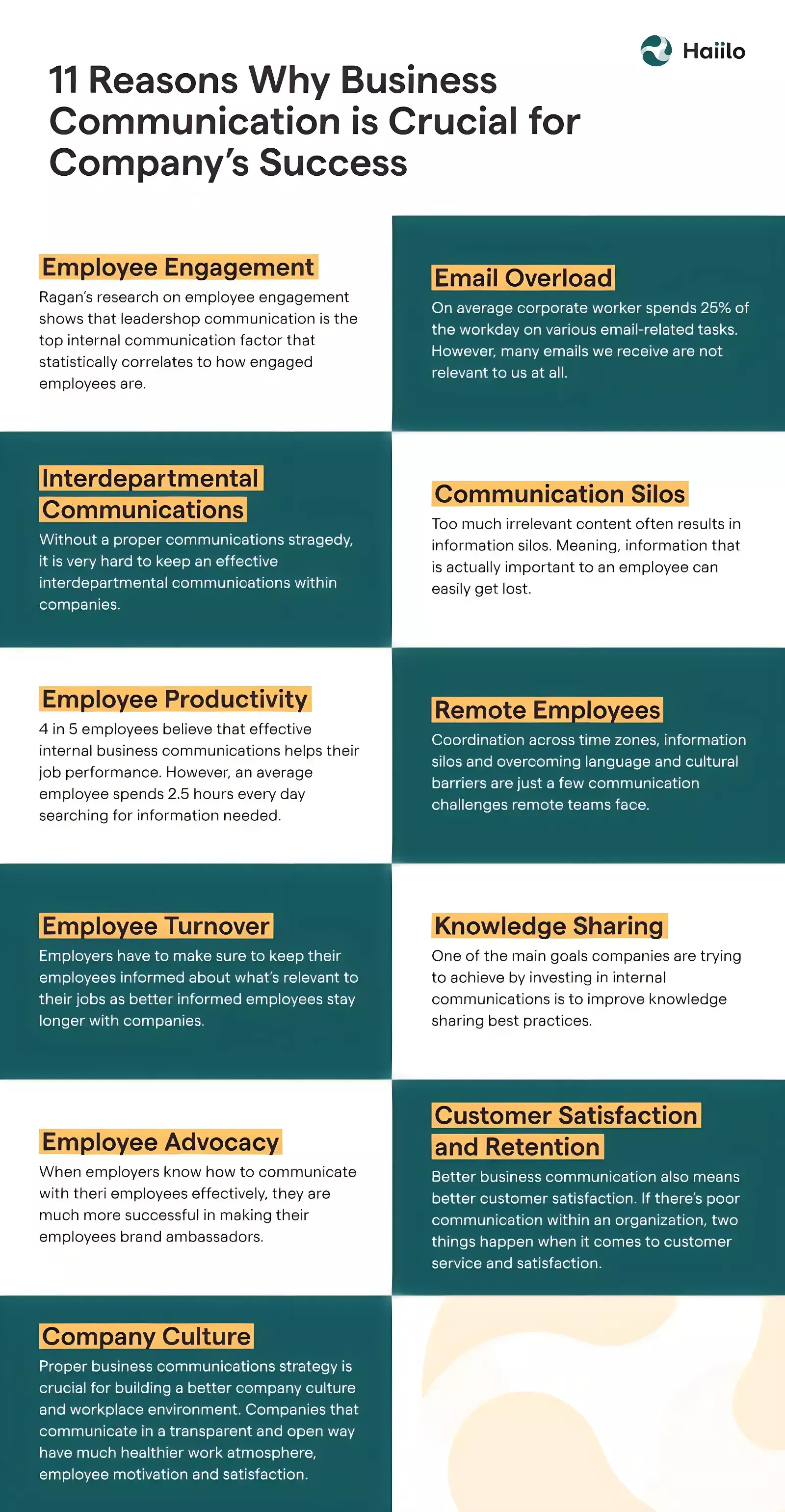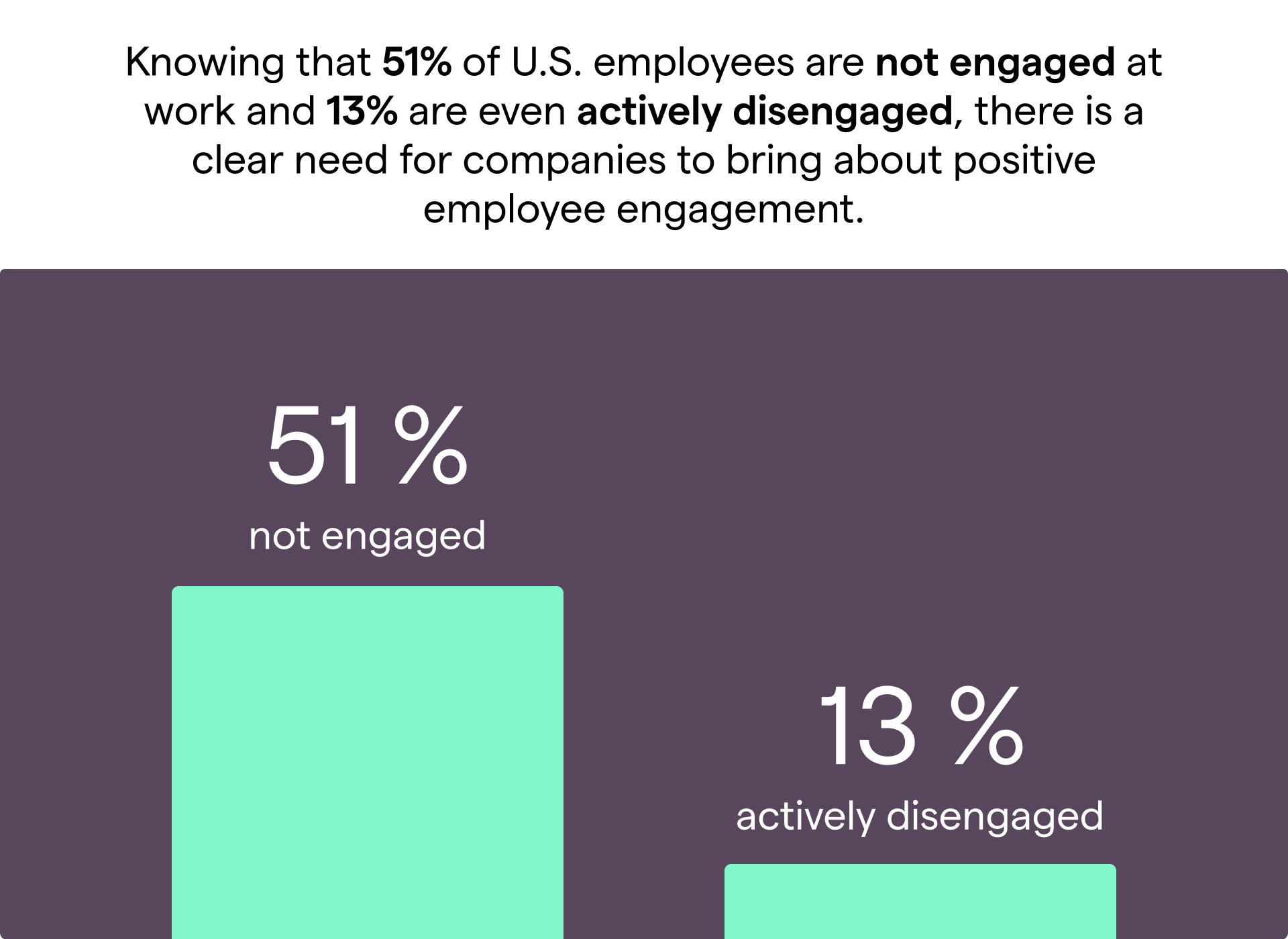Employee engagement has been the most popular topic among HR and other professionals for decades now. Today, when faced with unprecedented times, we are all becoming aware of the importance of other roles in driving a positive employee experience that ensures higher employee engagement levels.
Leaders, managers, crisis management, HR, internal communications, digital transformation, and other teams are all responsible for ensuring employee success in the workplace.
📚Download our eBook “How to Boost Internal Communication” and learn how to communicate with the modern employee in today’s digital age.
In this blog, we will go over the best practices for ensuring high employee engagement and motivation in the workplace.
Is Employee Engagement Disrupted?
In a recent article, Josh Bersin talks about how this crisis has positively affected employee engagement and experience in the workplace. Many other professionals have also defined this pandemic as a big opportunity for organizations to transform.

Research done in the middle of this pandemic shows that companies are treating their employees better than ever. Additional data from a new study done by Willis Towers Watson clearly shows that businesses are bending over backward to take care of their employees.
The main reason why we are seeing this shift towards increased employee engagement is that COVID-19 has created a level of transparency and trust we haven’t seen in decades.
The Willis research found that 90% of companies believe their culture has improved, 83% believe their employee experience is better, and 84% believe employee engagement has gone up.

Therefore, it seems like remote and hybrid work were a wake-up call to the fact that when people don’t feel safe, supported, or emotionally secure, they simply cannot do their jobs at their highest potential.
💡 Before we move forward, check out these powerful employee engagement stats!
Employee Engagement vs. Employee Experience
Employee experience is the sum of perceptions employees have about the organization they work for. It sits at the heart of delivering a superior customer experience and outstanding business performance.
Many people like to compare employee engagement and employee experience, and they use the terms interchangeably. This is wrong as employee engagement is the outcome of a positive employee experience.
Meaning, organizations need to take a step back in order to better understand what shapes a positive employee experience in the workplace.
During the pandemic, we saw that the importance of different EX components can change based on the situation. While some EX components were more important in the past, some new ones have been emerging lately.
Let’s take a look into what is driving a positive employee experience and, therefore, higher employee engagement.
10 Ways to Drive Employee Engagement
Even though the times have changed, most organizations are still looking for the same thing: excellence. In order to achieve such excellence, they are aware that they need to put their people first. Employee-centric organizations that put the focus on their people are the ones who have a big competitive advantage.
Take a look at the following image from the Wills Towers Watson research to better understand what it takes to drive higher employee engagement and by providing memorable employee experience:
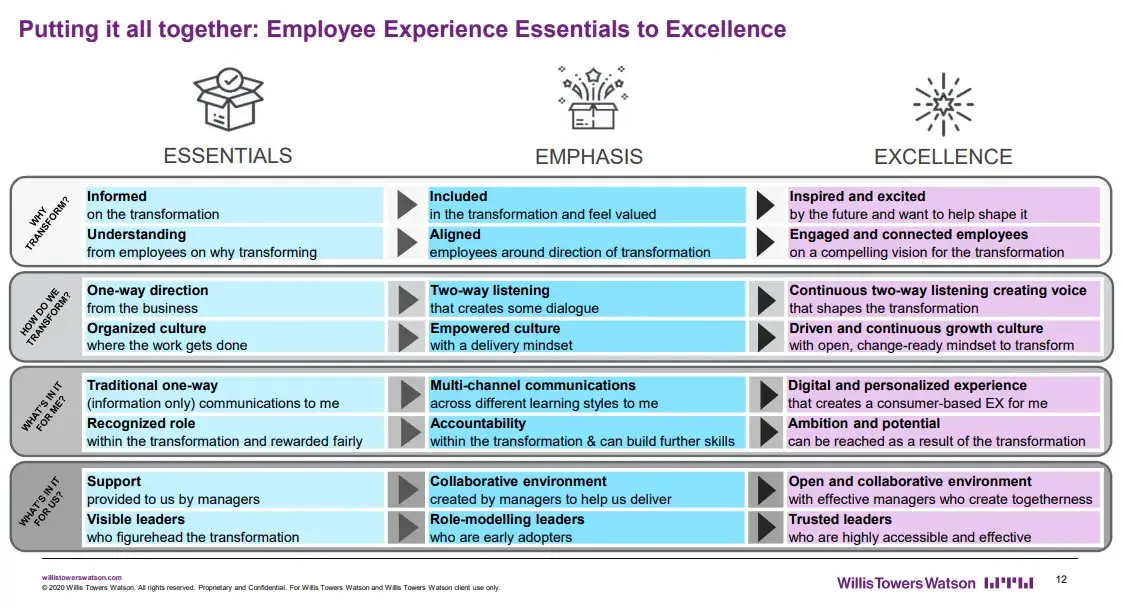
Note the “Excellence” column.
In short, to drive high employee engagement and experience levels, organizations need to:
- Inspire their employees and boost employee morale
- Empower employees to be a part of the big change
- Help employees understand the vision and how they contribute in achieving it
- Listen and encourage employees’ share of voice
- Implement digital tools that provide personalized experiences
- Create open and collaborative working environments
- Have approachable and trusted leaders
Let’s now take a deeper dive into the best practices for driving better employee engagement, reducing employee turnover, and creating a positive employee experience.
💡 Related: What Is Employee Journey and How to Map it Out.
1. Drive organizational alignment
Organizational alignment is a process of ensuring that the entire workforce understands, shares, and supports the company’s vision, goals, and core company values.
When employees are aligned with the company’s strategic goals, it’s easier to drive their engagement because they invest more to achieve business goals together.
Even though this has always been the goal for many employers, today we can see a higher focus on driving organization alignment so that all employees can work towards the same goals.
With the emergence of remote work, it may be harder to achieve such alignment, and employee communications plays the most important role here.
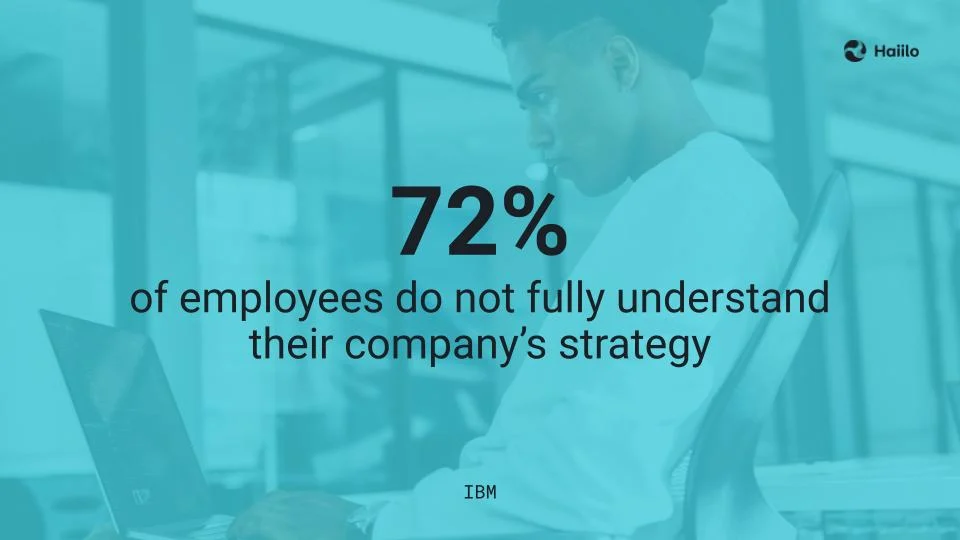
Therefore, internal communicators, HR professionals, and leaders need to continuously ensure that the entire workplace is aligned and connected.
2. Continuously build trust in the workplace
Building trust in the workplace is more important than ever. During these unprecedented times, we have learned that trust in the workplace significantly impacts employee engagement and productivity.
PwC revealed that 55% of business leaders strongly believe that a lack of trust in the workplace constitutes a foundational threat to their business.
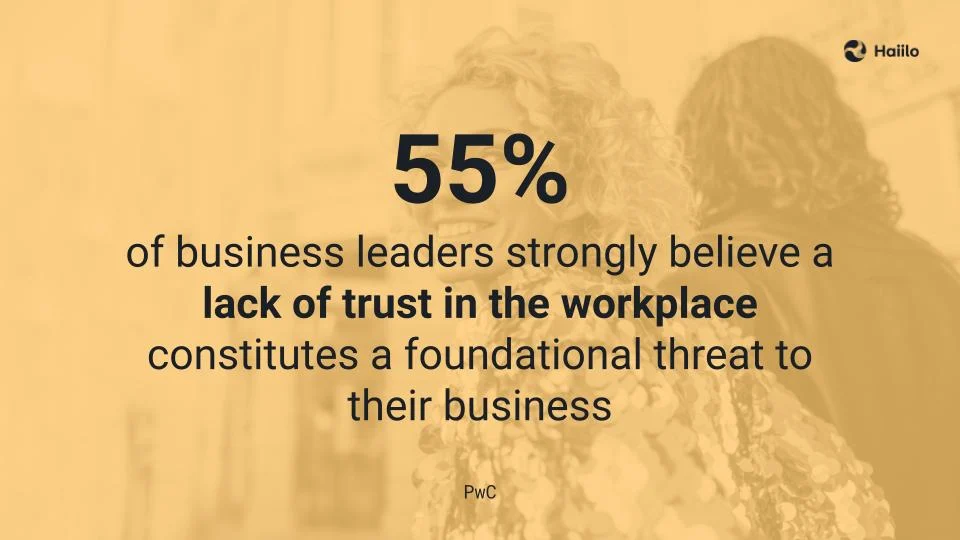
Another study found that, compared with employees working at low-trust companies, employees working at companies that cultivate trust:
- Feel 74% less stressed
- Are 106% more energetic at work
- Are 50% more productive
- Are 13% less willing to call in sick to work
- Feel 76% more engaged
- Report a 29% higher satisfaction with their lives overall
- Are 40% less likely to cope with burnout
Similarly to driving organizational alignment, IC, HR, and leadership need to work together to ensure that employees feel supported by their employers.
3. Create a working environment that supports remote work
A recent survey of 2,000 participants in flexible work arrangements in China indicated that 63% were supportive of remote work, with 55% believing that their employer has provided them with the software, tools, and resources to work effectively.
Even though this data shows improvements regarding digital transformation in the workplace, some employers are still struggling to find digital solutions that best support remote work and enable employees to stay connected and engaged.
Effectory research shows that such tools that ensure seamless remote work can make your employees 63% more productive and 52% better able to collaborate.
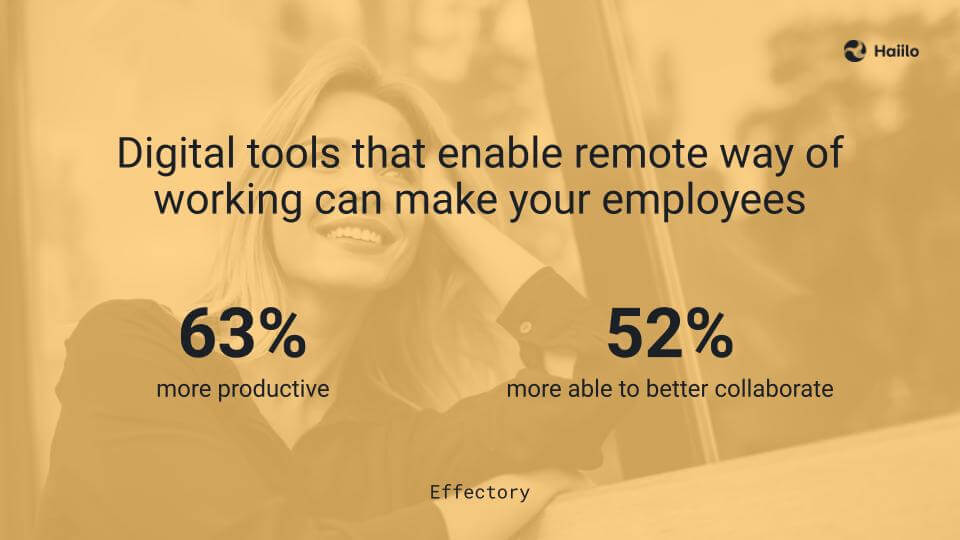
With large numbers of employees working from home, and we are expecting this trend to become the new normal, it is important to ensure that all employees retain a strong sense of connection which directly impacts employee engagement.
Employers need to consider implementing new employee communications solutions that will serve as a central place for employees to start their days.
Currently, your workforce is probably using various communication channels such as email, intranets, tools such as Slack and Microsoft Teams as well as other document sharing tools. With that, the employee communications ecosystem has become extremely complex.
Take the complexity out of your internal communication
How? By unifying all communication channels into one platform
4. Change the culture of leadership
Leaders and managers play an important role in driving employee engagement. Moreover, they account for over 70% of the variance in employee engagement. Today, their role is even bigger.
As Josh Bersin puts it: “the CEO is now the Chief Empathy Officer. And this is really happening.” Employees expect their leaders to set clear directions, to work on building stronger relationships, to stay in touch, and to keep them informed.
While these might not be the main priorities in the past, the current pandemic is completely reshaping Human Capital Management and, with that, the way managers motivate and engage their employees has also changed.
Today’s leaders need to be excellent communicators, they need to speak with an authentic voice and be able to inspire their people.
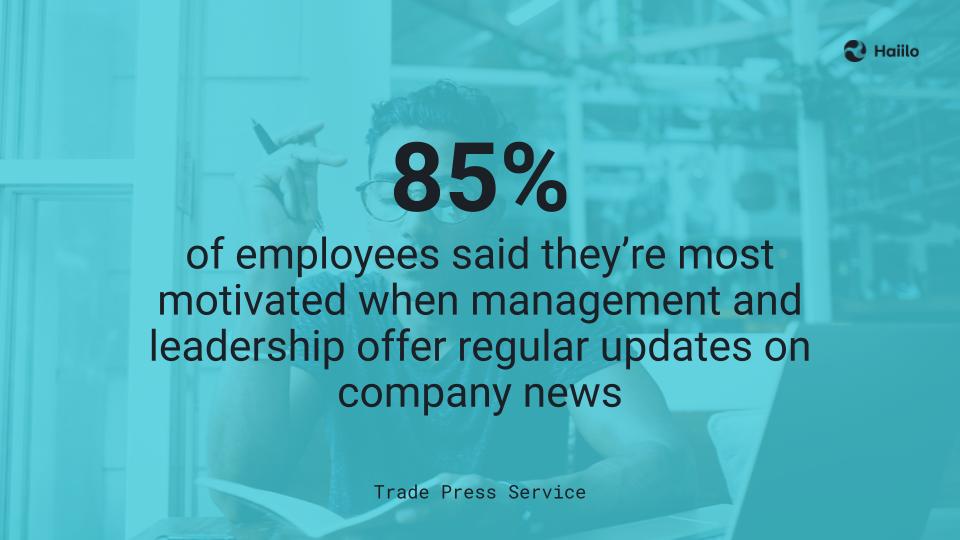
Moreover, according to research, communication executives are heavily involved with the COVID-19 crisis response and nearly all (93%) said their company’s leadership has done well.
5. Encourage “social” collaboration
As seen on the employee excellence image, collaboration in the workplace is an important factor in shaping positive EX and driving employee engagement.
Even though we have been experiencing social distancing restrictions in the past few months, we still need to make sure that our workplaces stay “social” and our employees stay connected in order to collaborate effectively.

boost in the implementation of social employee communications technologies within organizations across the world. Such tools mimic your employees’ favorite social media platforms that they use in their private lives.
Using them, employees have an easy way to join the company’s conversations and drive meaningful conversations with their colleagues. Remember, internal communication drives collaboration. When communication and information flow freely and openly among peers from different departments, it inspires efforts to collaborate.
6. Enable easy peer-to-peer, to-down, and bottom-up feedback
One of the biggest drivers of employee engagement is employee feedback from both their managers and peers. However, instead of just providing annual performance reviews, you need to ensure on-the-spot, frequent employee feedback.
Employees want instant feedback on their work as this creates a sense of achievement and accomplishment. Therefore, we need to find ways to restructure employee feedback and make it a part of daily conversations in the workplace.
7. Ensure seamless access to important information and stop the information overload
Due to the pandemic, many organizations have been updating their working policies and procedures. Moreover, companies with strong policies and procedures for emergencies are better positioned to address the challenges of the COVID-19 pandemic.
Additionally, employers have started communicating information that they didn’t have to before this pandemic. When asked about what type of information they share with their employees, here is what they said.
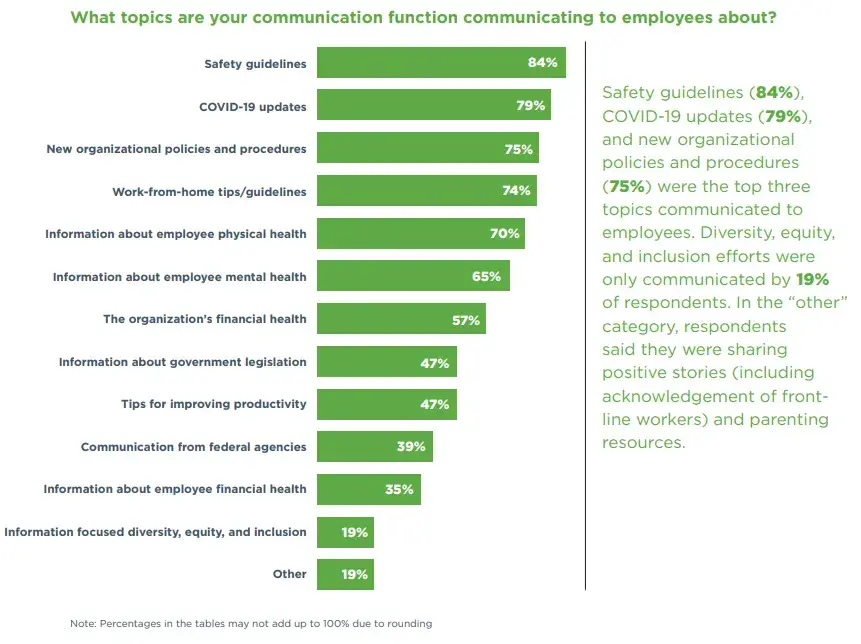
📚 Check out our guide for communicating safety tips to your employees.
Therefore, ensuring that the right information finds the right employees at the right time has become critical. However, many organizations are struggling when it comes to ensuring that all the important information and company updates are actually delivered to, and consumed by, their employees.
Employers need to understand that not being able to find critical company information not only frustrates employees but it also results in decreased employee engagement as search for relevant information is proved to be one of the biggest blockers of shaping positive EX and driving higher employee productivity.
8. Listen, listen, listen
Lately, we can see more organizations use employee surveys so that they can better understand their employees. This has been a trend for years, but it accelerated overnight. People want to be heard and they expect complete transparency in the workplace. Yet, many employees don’t feel like their voice is heard and this has a negative effect on their engagement.
In order to show empathy and care for your employees’ wellbeing, you first need to listen to their needs and concerns in order to provide an exceptional experience and to drive and increase engagement.
However, just sending a survey will not fix the problem of silos, misinformation, and lack of employee engagement. The conversation must go two-way. In other words, employees should be able to join the company-wide conversations on a daily basis. This is the only way to keep them motivated to go the extra mile.
9. Frequently communicate what your organization stands for
Employees who live by your core company values, and are proud to be your employee, are much more likely to also be more engaged. However, employers are the ones that should constantly remind their people about what their organization stands for.
According to research, when employees feel a sense of purpose, they will have 49% more confidence in the future of your organization and a 42% higher NPS — the likelihood that your employees will recommend your organization to people that they know.

In the past few months, many organizations have shown the world how they are following their social and corporate responsibilities. Many of them have been helping the community to overcome the crisis as painlessly as possible. Your own employees should also be aware of all these initiatives, and they should be encouraged to share those news with others within and outside your organization.
Not only that having brand ambassadors has a significant impact on talent attraction and retention, but it also develops a sense of pride, inspiration, and achievement among your own employees.
10. Support your employees’ growth and development
Even though job security has become an important factor for workers across the world, career growth and development still play important roles in driving employee engagement.
Moreover, many organizations are now struggling to close the skill gaps, and this problem will continue to grow. Employers should see this as an opportunity to educate and grow their employees internally.
Such an approach doesn’t only help you deal with the talent shortage, but also motivates your employees as they can envision their career paths at your company.
💡 Also, learn about what are employee engagement apps and how can they help you drive employee engagement in the workplace.
The Benefits of Driving More Employee Engagement in the Workplace
As mentioned earlier, employee engagement has a big impact on employee productivity, business performance, employee morale, retention, and even talent attraction.
Check out these few powerful stats that prove the importance of driving higher employee engagement in the workplace:
- 71% of executives say that employee engagement is an important contributor to organizational success.
- Gallup’s report on employee engagement shows that companies with a highly engaged workforce have 21% higher profitability
- A study on employee engagement found that companies in the U.S. lose between $450-$550 billion each year due to disengaged workers.
- According to a survey by Hays, 47% of active job seekers want to leave their job because of bad company culture.
- According to a Korn Ferry survey, 33% of employees jump ship because they feel bored in the workplace and want to find new challenges.
The Importance of Communications in Driving Employee Engagement
As mentioned earlier, internal communications departments are now considered as one of the most important strategic business partners. Even though their role in shaping a positive employee experience, increasing productivity, and driving employee engagement may have been overlooked in the past, this is completely different now.
Transparency, trust, collaboration, empathy, alignment, and strong relationships are impossible to achieve without the proper employee communications strategy in place.
In order to better understand the role of IC in employee engagement and productivity, take a look at our infographic below 👇
